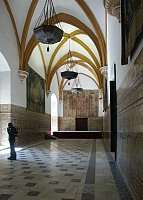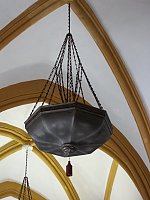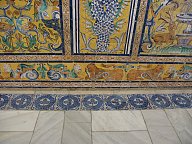Salas de las Fiestas (or Halls of Celebrations), 1576-88 This area had been rebuilt in the middle of the 13th century (under Alfonso X) and is therefore older than the Mudéjar Palace or the rooms on the preceding pages. The exterior of the Gothic Palace had buttresses and crenelation with towers at the four angles. The palace consisted of four rooms, two of them parallel to the patio and the existing gardens today. The rooms had rib vaults supported by pillars. These rooms in the so-called Gothic Palace were transformed in the Renaissance. |

|

|
Left: note Mannerist corbels designed by Asensio de Maeda (1577-78)Renaissance changes including the addition of colorful ceramic tile dados and the replacement of the supporting pillars with Mannerist consoles/corbels. |
| |
|
Tile dado by Cristóbal de Augusta (1577-78)Somewhat like tapestries, the dados have a lower frieze, two upper friezes and a central panel framed by vertical borders. The lower frieze continues around the rooms and features pairs of animals, faced to face. The lower of the upper friezes has snakes, birds and cherubs with central urns while the upper frieze has the coats-of-arms of Spanish royalty and the words Plus Ultra relating to the virtues of Charles V.
|
Center: the lowest level, showing part of the floor; right: the four registers of the entire dado |

|

|


 Click here to return to index of art historical sites.
Click here to return to index of art historical sites.
 Click here to return to index of artists and architects.
Click here to return to index of artists and architects.
 Click here to return to chronological index.
Click here to return to chronological index.
 Click here to see the home page of Bluffton University.
Click here to see the home page of Bluffton University.
